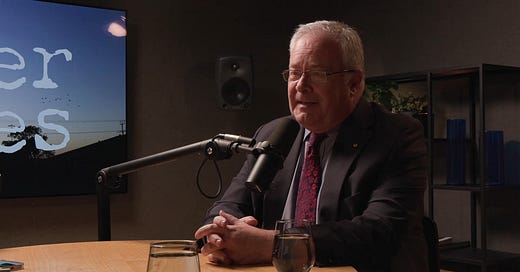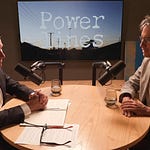Canberra warns that our region faces the gravest military threat since World War II. But defence spending suggests it doesn’t believe it.
Peter Jennings, director of Strategic Analysis Australia, told Powerlines the gap between words and actions is unsustainable.
“To use an old Trotskyism… we may not be interested in a war, but war may well be interested in us.”
In an interview conducted before Israel attacked Iran, Jennings argues the West is facing an historic challenge from a coalition of tyrannies.
“The big story of our generation is the rise of China, now with the grouping of authoritarian powers around it—Russia, North Korea, Iran... All of them presenting a threat to the global order.”
He’s scathing about Australia’s strategic complacency.
“There seems to be a complete disconnect between that judgment, which everyone in Canberra shares, and what do you do about it? Because successive governments have simply failed to lift the level of investment in defence.”
Jennings traces the shift in urgency among Australia’s defence planners to the Morrison government’s 2020 strategic update, which concluded that we no longer had 10 years to prepare for conflict. Labor’s subsequent strategic reviews backed that assessment, but five years on, defence spending has barely budged.
“Successive Australian governments, really since the end of the last Cold War, have desperately wanted to see security delivered on the cheap... we spend something like two percent of gross domestic product on defence and have done for 30 years.”
The Albanese Government talks a good game on defence spending, but most of the planned increases are incremental. Meanwhile, China’s military transformation has been radical.
“China has moved from... being a vast land-based organisation which was primarily about creating internal stability inside China... into being a very high technology, tri-service military... with the ability to project military power at great distances.”
The People’s Liberation Army now boasts “long-range missiles, ships and aircraft with significant reach,” and is “significantly expanding their nuclear weapons holdings.”
China is flexing its muscles. It has established foreign bases, claimed much of the South China Sea, and is routinely confronting foreign navies, including Australia’s.
“Now every time an Australian ship sails through that region... it's going to come under severe pressure to get out of Chinese waters.”
He’s also critical of how Australia has reacted to provocations. When Chinese warships circumnavigated the Australian continent, “the most embarrassing thing of all... was that our Prime Minister, our Foreign Minister and our Defence Minister all came out and defended China in terms of what it was doing.”
The gap between Australia’s rhetoric and reality is fuelling American frustration. US Defence Secretary Pete Hegseth recently told Defence Minister Richard Marles that Australia should lift its defence spending from two to 3.5 per cent of Gross Domestic Product.
“It couldn’t have been more blunt. And I think more of that’s coming.”
Yet, Jennings says the Albanese government has doubled down on long-term capabilities at the expense of readiness today.
“In order to pay for that fantasy force of the 2040s... they’ve cut a whole range of capabilities out of the current Australian Defence Force.”
He gives example after example: early retirement of Navy ships, axed upgrades, cancelled support vessels, reduced missile programs, a gutted armoured vehicle project—and helicopters “broken up, sold some bits for spare parts and buried the rest.”
“Our 2025 force... would not be able to mount the sort of stabilisation role we played in East Timor in 1999.”
So what happens if a war breaks out over Taiwan?
“If China attacks Taiwan, I can tell you this—we won’t be exporting iron ore and coal to China during that period... Most global shipping will have stopped... We’ll be on rationing the minute there’s a blockade around Taiwan.”
That’s because most of Australia’s fuel is shipped through the South China Sea and our reserves are pitiful.
“We’ve got about, at best, a fortnight, maybe three weeks’ worth of petrol supply.”
Beyond hardware, Jennings points to deeper vulnerabilities—cyber warfare and political cowardice.
“There’s a lot of Australian critical infrastructure which is now vulnerable to sabotage... hostile forces planting malware.” He warns that “cyber attacks against critical infrastructure will be the first stage of any military campaign.”
So what must be done?
“We need sort of an emergency, all-out effort to make the existing defence forces current and capable, as operationally ready to go as we can make them in the next six to 12 months.”
That includes lifting spending and rearming the defence industry. Jennings notes that Australian firms are “really struggling... because they can’t get contracts out of the Defence Department.”
Finally, he returns to the core political failure: spin over substance.
“We’ve now got a government which is incapable of talking to the Australian people about the strategic threats that we face. And on that basis, why would anyone want to increase defence spending if you can’t actually explain what the threat might be?”
If Australia’s strategic position is as perilous as our leaders say it is, Jennings has a blunt response:
“It’s never too late to start on making your own defence capability stronger. Every day is a good day to start the pushback.”
Link to Strategic Analysis Australia here.











Share this post